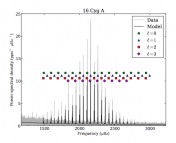Authors: T. Z. Dorn-Wallenstein, E. M. Levesque, K. F. Neugent, J. R. A. Davenport, B. M. Morris, K. Gootkin
First author’s institute: University of Washington Astronomy Department, Physics and Astronomy Building, 3910 15th Ave NE Seattle, WA 98105, USAStatus: Accepted for publication in the Astrophysical Journal
What happens to the most massive stars?
Large or small, young or old, stars of all walks of life oscillate in brightness over time. These oscillations are often due to standing waves forming inside the star, and the study of such standing waves is called asteroseismology. Since these standing waves travel through the stellar interior but produce observable oscillations, they can be used to study the insides of stars by only observing their surface.Today’s authors set out to use asteroseismology to solve a problem. When studying Type II supernovae and modelling their progenitors, no supernovae appear to have come from massive Red Supergiant stars (RSG) above a certain mass (around 20 times the mass of the Sun). However when looking at the night sky, we do observe RSG stars above this mass limit. So how do these stars end their lives, if it’s not as a supernova? This discrepancy is called the “red supergiant problem”.
Targets old and new
The authors of today’s paper wanted to use asteroseismology to delve into the physics of RSG stars, to see if their oscillations provide insight into the inner workings of RSGs at high masses. To do this they used new data from the space-based TESS telescope, which can be used to study stellar oscillations. To form their stellar sample, they cross-matched stars observed by TESS with known supergiants with well known temperatures and luminosities, both in the Milky Way and the Large Magellanic Cloud. Through this crossmatch they identified 48 RSGs, and 28 Yellow Supergiants (YSGs) (which are slightly hotter but have a similar luminosity), that were observed by TESS.To observe whether any of these massive stars exhibited strong oscillations that could be used for asteroseismology, the authors studied the power spectra of these stars, the result of taking the Fourier Transform of their time-series observations. First, the authors fit a model to the low frequency noise background (see Figure 1), and divided that out, to make large-scale stellar oscillations clearer. The results of these can be seen plotted in Figure 2, where each spectrum marks where the corresponding star would fall on an HR diagram. . In this figure, there are 9 stars that stand out: four at higher, ‘blue’ temperatures (shown in blue on the figure), and five in the ‘yellow’ regime (shown in green on the figure).
What type are these oscillating stars?
Different regions of the HR diagram house stars of different oscillating types. This can be seen for example on Figure 2, where the Cepheid instability strip is shown. Stars within this region show oscillations similar to those observed on Delta-Cepheid, whereas stars outside this region don’t (or may oscillate differently). So do the oscillations observed by today’s authors place their massive stars in an already-known oscillation category, or is it a new class of oscillator altogether?
First, let’s address the four ‘blue’ stars. These stars find themselves close to a region associated with the known class of Alpha Cygni oscillators. In previous studies, the authors found that one had been identified as an Alpha Cygni variable, and three that had not. Due to their proximity to one another in the HR-diagram, they identified all four as belonging to the Alpha Cygni class.
The five ‘yellow’ oscillating stars are more intriguing. This region of the HR diagram is devoid of other stars, and none of the stars around them are oscillating. It is also well separated from the yellow void — a region where dynamical instabilities are high — and the Cepheid instability strip. This would imply a new region of instability unique to this kind of massive star.
In studies such as this, it always pays to be careful and make sure that no astronomical noise or detrending procedures have caused oscillations to appear where there are none. The authors perform checks to make sure that these stars don’t appear to be oscillating by chance, or by mistake. They carefully rule out the presence of blending with background stars, spurious signals, and the probability that these stars occupied this region of the HR diagram together by chance. Following their testing, they conclude that these five stars represent a true new class of stellar oscillator, which they dub “Fast Yellow Pulsating Supergiants” (FYPS).
What does this mean for the Red Supergiant Problem?
Not much — yet. The authors propose that FYPS stars might be RSG stars that have not gone supernova but instead lost so much mass that they increase in temperature. This would explain the lack of high-mass RSG supernova progenitors— because the progenitors are actually hotter, ‘yellow’ stars! However, verifying this with such a small sample of stars is difficult. And while the authors carefully extract and study the oscillation frequencies of these stars, the stellar models in this region of the HR diagram do not adequately capture those frequencies necessary to understand the interior physics of these stars.
As the authors mention in their paper, the first step forward is to identify more FYPS stars. By increasing their numbers, it will be easier to discern whether the FYPS phase occurs before or after the RSG stage. In their sample of 28 stars, 19% were found to be FYPS stars. Extrapolating this to all YSG stars known to be observed by TESS, there may be up to 58 FYPS stars yet to be discovered in TESS data. Finding and studying this larger sample of stars will be the key to understanding these massive oscillators.
Featured image credit: ESO/M. Kornmesser




